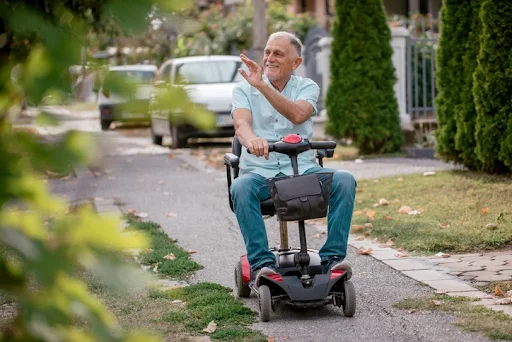Mobility is an essential part of independent living. For millions around the world, personal mobility aids (PMAs) offer freedom, confidence, and ease in everyday life. As technology advances, these aids are no longer limited to basic walking sticks or manual wheelchairs. Instead, they now include smart, motorised, and electric options designed to adapt to diverse needs. From intelligent sensors to foldable designs, today’s personal mobility solutions are transforming how people move. Companies like ELFIGO Mobility are part of this movement, offering innovative options that are both practical and user-friendly. In this blog, we’ll explore the top innovations in personal mobility aids that are shaping the future and making movement safer, smoother, and smarter for users of all ages.
There’s so much more to discover—browse our related posts!
The Shift from Traditional to Tech-Driven Mobility
Earlier, personal mobility devices were relatively mechanical, simple devices such as canes, walkers or manual wheelchairs. Those tools were useful but there was a setback as they were related to the lack of comfort, flexibility, and control by the user. Things are very different nowadays. An example of a design like the motorised wheelchair offers power movement that can be dictated by speed and direction, offered under the control of a joystick or even voice Control. This transition has greatly decreased the fatigue of the users and enhanced independence. The manufacture of electric wheelchairs now offers options of customized seats, terrain flexibility, as well as more safety. With increasing innovation, the aim has been diverted to ensuring that such devices become more responsive to the needs of the people, making sure that comfort, ease and digital intelligence are integrated into it.
Lightweight and Foldable Designs: A Game-Changer
The creation of lightweight and foldable mobility aid designs is one of the handiest inventions in the sphere of mobility aids. It could either be a mobility scooter or an electric wheelchair but in either case, the users have their sights set on convenience when traveling. Newer PMAs are easily foldable and easily fit in truck trunks or can even be transported in planes. This portability has changed the lives of those users who like to travel and even those who find the need to do so frequently as doctors or the parks or shopping centres. The compact designs are also beneficial in the sense that the equipment can be transported by the caregivers without jeopardizing the durability and safety of the equipment. Folding mobility scooters are particularly in demand among aged people and citizens who live in cities with confined storage facilities at home.
Smart Controls and Connectivity
The world of technology seems to be incorporated with healthcare instruments, including PMAs. Most modern gadgets are coming in with smart controls that can be operated using smartphones or using remote systems. Technologies such as GPS tracking, battery health and obstacle detection are going mainstream. There are newer electric wheelchairs that are paired with mobile apps and users of them, or caretakers, are able to monitor where the chair is or even make adjustments in real-time. Models based on voice controls and AI navigation are under testing. These technologies offer greater levels of autonomy, especially for persons who have limited dexterity in their hands for people who are immobile.
Improved Battery Life and Charging Options
An important feature of motorised mobility aids is battery life. Previously, a short range of battery range meant it was hard to use over long distances. Recent innovations, however, have produced more powerful and more durable batteries. Its iteration is lithium-ion batteries, which have become the standard in the industry as the charging time is faster and the battery has a longer life. And some have extended up to more than 20 kilometres on a single charge of an electric wheelchair. There is also development on solar-powered charging and wireless, especially in areas where power is not easily accessible. Such developments have made sure that the user can freely move without necessarily having to fear that at one moment or another, their device can run out of battery.
Custom Fit and Ergonomic Designs
New PMAs are paying tremendous attention to comfort. Ergonomic designs are ergonomically shaped, such as using padded seats, adjustable armrests, reclining back support, and foot rests according to the body types of the user. One of the important innovations has been the introduction of pressure relief systems to extended sitting sores. In addition to this, mobility scooters are now fitted with adjustable handles, mirrors as well as suspension systems so that mobility on different terrains can be smooth. Providers such as ELFIGO Mobility have realized that there is a need to incorporate health-friendly functions that can still be functional in everyday life. Such customization features shall enable people to experience a sense of support and comfort, which is key to the long-term usage of the product.
Features of Smart Mobility Scooters
- Anti-tip technology for added safety on slopes
- LED headlights for nighttime travel
- USB charging ports for phones or hearing aids
- Swappable batteries for extended travel
- Keyless ignition systems for ease of use
- Rearview mirrors and horn systems for visibility and alerting pedestrians
- Digital dashboard displaying speed, battery, and alerts
Environmental Awareness and Sustainable Designs
The importance of sustainability is increasing in many industries, including the one in which mobility aids are produced. Most of the current personal mobility devices are being manufactured using recyclable materials and power-saving mechanisms. Electric choices curtail the consumption of gasoline alternatives in the form of mobility devices, minimizing the carbon footprint of the user. Companies are striving to have solar charging desks or biodegradable seat covers. These environmentally friendly measures serve not only the environment but also help to make users realize the significance of the conscientious selection of products. The future devices can be completely green both in design and operation, as these innovations become more mainstream.
Inclusive Technology for Diverse Needs
Individual mobility becomes part of the design in personal mobility aids are no longer in a one-size-fits-all kind of design. The needs of the users today can be radically different, i.e., some need to be assisted with walking shorter distances and others require a full-time assistive all-day exercise. This is the reason why inclusive technology is emerging. As an example, mobility scooters can now be adapted to left or right-hand drive. Powered wheelchairs may also be adapted to adaptive controls such as chin or sip-and-puff controls in people with high-level disabilities. Such personalisations enhance the inclusivity of devices and provide them with a sense of respect and power.
FAQs
What is a personal mobility aid (PMA)?
A PMA is any device that helps individuals move independently. This includes canes, walkers, wheelchairs, mobility scooters, and other assistive tools.
How is a mobility scooter different from an electric wheelchair?
A mobility scooter is typically used for individuals with some walking ability and is controlled with handlebars. An electric wheelchair is joystick-controlled and suited for those with limited mobility or strength.
Can mobility aids be taken on airplanes?
Yes, many modern aids like foldable electric wheelchairs or scooters are airline-approved. Always check with the airline for specific regulations.
How long does a motorised wheelchair battery last?
Battery life varies by model. On average, a fully charged battery may last between 10 to 25 kilometres depending on usage and terrain.
Conclusion
The world of personal mobility aids has undergone a remarkable transformation—from simple walking tools to intelligent, adaptable machines. Innovations like foldable designs, smart controls, and ergonomic improvements are helping individuals lead more active and independent lives. Brands such as ELFIGO Mobility are at the forefront of this movement, contributing to a more inclusive and accessible future. Whether it’s a motorised wheelchair, a compact mobility scooter, or a fully integrated PMA, the advancements are clear. These innovations are not just upgrades—they’re life-changing tools, giving users renewed control over their mobility, freedom, and dignity.
Don’t miss out on more great reads—click through our featured posts!






